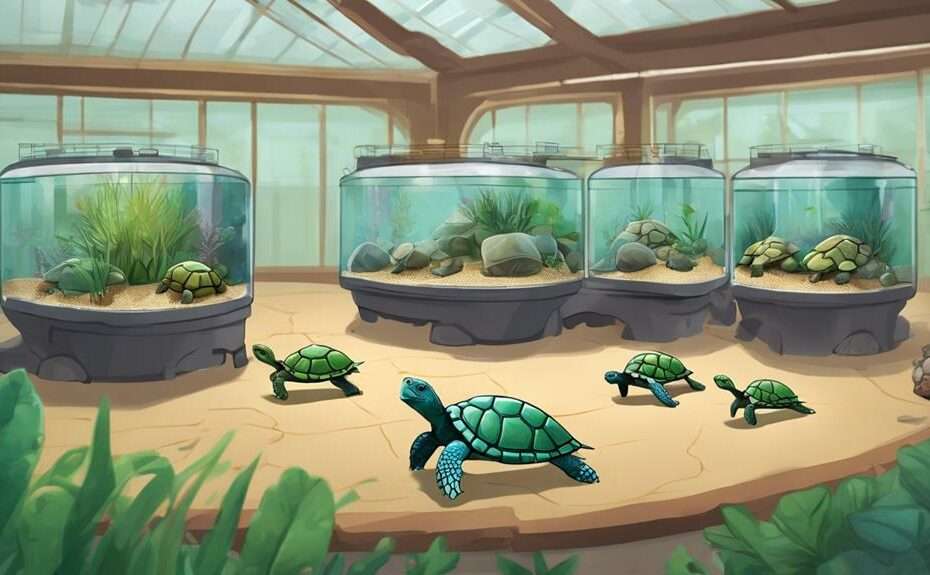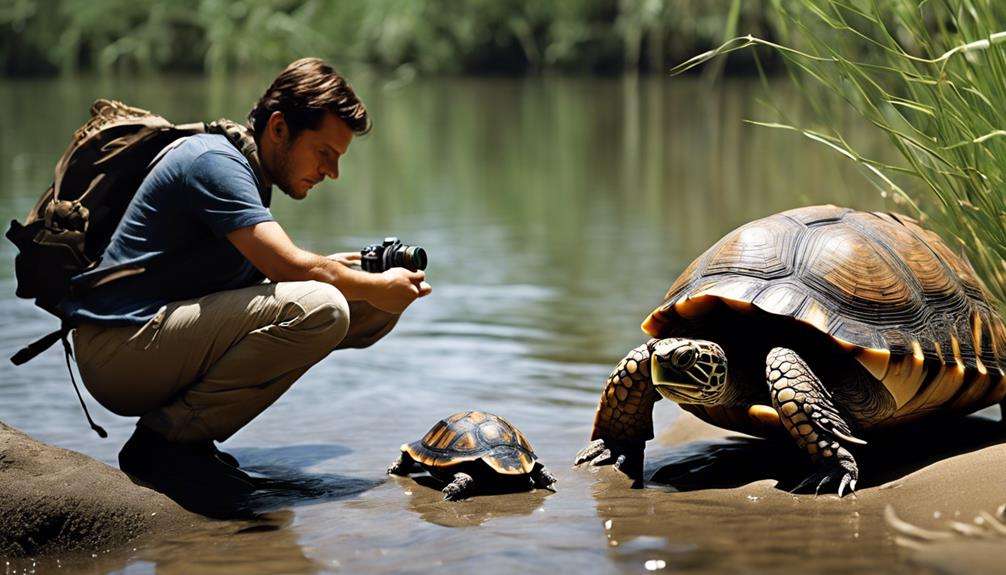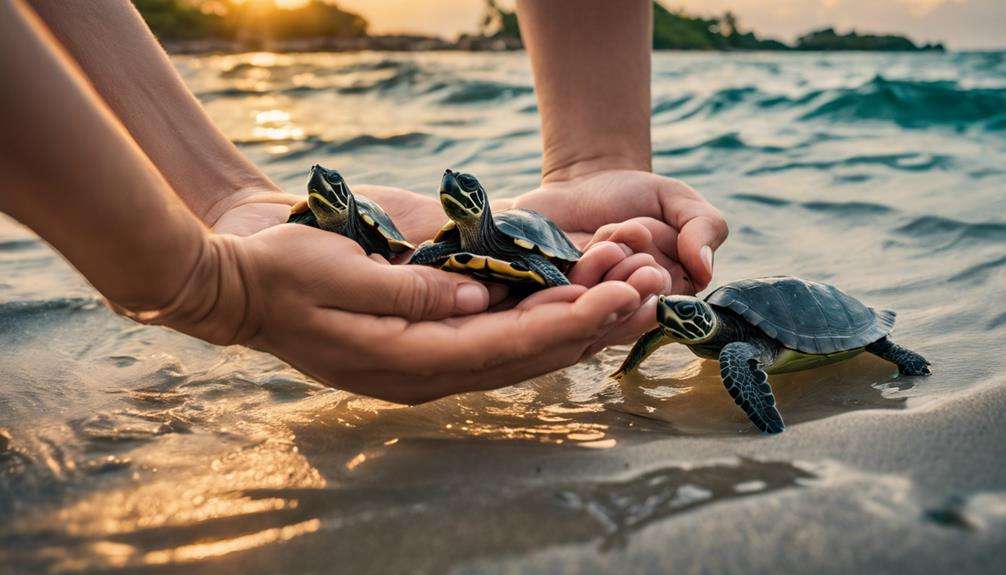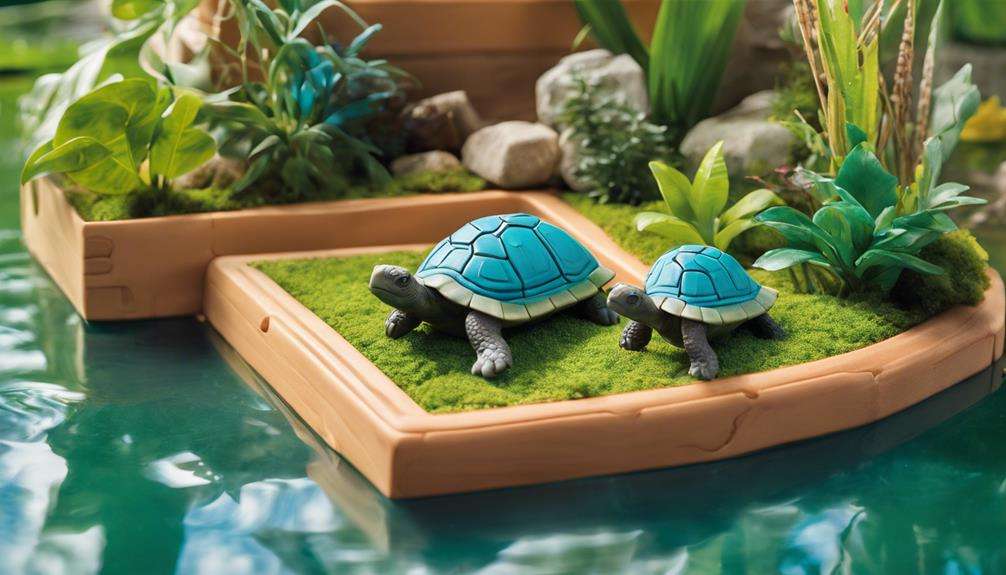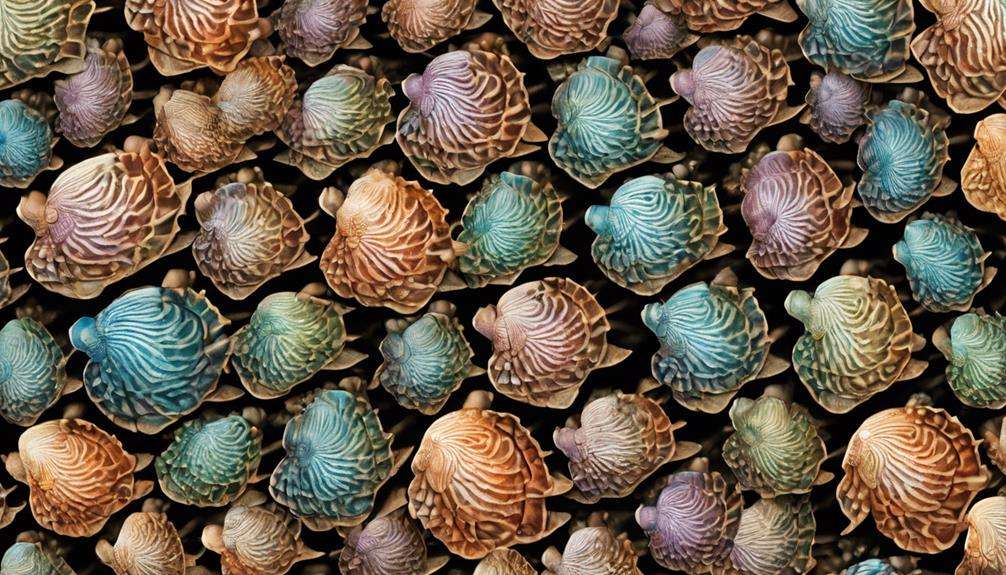So, you think breeding uncommon turtle varieties is as easy as pie? Well, think again. There's a whole world of intricacies and specialized knowledge waiting for you in the domain of turtle breeding.
From deciphering their unique courtship dances to creating the perfect nesting environment, every step in the breeding process is a delicate dance of precision and care. But fear not, for by mastering these breeding tips, you might just uncover the secrets to successfully propagating these extraordinary turtle species.
Key Takeaways
- Select breeding pairs based on genetic diversity and compatibility for successful reproduction.
- Provide precise temperature control to support courtship, mating, and egg development.
- Create ideal nesting environments with suitable substrates for nesting behaviors.
- Manage lighting effectively to regulate circadian rhythms and enhance reproductive success.
Unique Turtle Breeding Challenges
Breeding uncommon turtle varieties presents unique challenges that stem from their specific dietary requirements, nesting behaviors, limited availability of breeding partners, environmental conditions, and insufficient research on their breeding biology. When breeding turtles, understanding their dietary preferences is important. Some uncommon turtle species have specific nutritional needs that must be met for successful reproduction. This includes providing a varied diet that mimics their natural food sources to guarantee good health and breeding conditions.
Additionally, nesting behaviors play a significant role in the breeding success of uncommon turtle varieties. Certain species may exhibit unique nesting preferences, requiring careful observation and adjustment of nesting environments to encourage successful egg laying and incubation. Understanding these behaviors is essential for creating suitable nesting conditions that support breeding success.
Furthermore, the limited availability of breeding partners due to the rarity of uncommon turtle varieties can pose challenges. Breeding programs often face difficulties in finding suitable mates for individuals, necessitating collaboration between institutions to guarantee genetic diversity and successful breeding outcomes. Addressing these challenges requires strategic planning and coordination to overcome the obstacles posed by limited breeding partners among uncommon turtle species.
Environmental Factors for Breeding Success
To achieve successful breeding outcomes with uncommon turtle varieties, it's important to meticulously control temperature levels and maintain ideal humidity.
Lighting plays a significant role in the breeding behavior of certain uncommon turtle species, so ensuring appropriate photoperiods is essential.
Temperature Control Importance
Maintaining precise temperature control is paramount for the successful breeding of uncommon turtle varieties. These species have specific temperature requirements for courtship, mating, and egg development. Temperature fluctuations can disrupt breeding behaviors and impact egg viability in rare turtle varieties.
To mimic natural conditions, provide a gradient of temperatures within the breeding enclosure. Consistent monitoring and adjustment of temperatures are critical factors in successfully breeding uncommon turtle varieties. Make sure the temperature ranges align with the specific needs of the turtle species you're breeding.
Lighting Effects on Breeding
Proper lighting management is essential for regulating the circadian rhythms of uncommon turtle species, influencing their breeding behaviors. Lighting effects play a critical role in the reproductive success of these turtles. Providing a natural light cycle with appropriate UVB exposure is key for enhancing overall health and promoting successful breeding.
Incorrect lighting conditions can disrupt breeding cycles, leading to reduced mating activity and egg production in uncommon turtle varieties. It's imperative to contemplate the specific lighting requirements of each species based on their natural habitats, whether tropical or semi-aquatic.
Consistency in maintaining the right lighting conditions, including intensity and duration, is crucial for encouraging breeding behaviors in uncommon turtle varieties. By understanding and implementing proper lighting effects, breeders can significantly enhance the reproductive outcomes of these unique turtle species.
Selecting Ideal Breeding Pairs

How can you guarantee maximum genetic diversity and compatibility when selecting breeding pairs for uncommon turtle varieties?
When choosing breeding pairs, it's essential to take into account genetic diversity to maintain healthy populations. Look for turtles with strong physical traits, good health, and a proven reproductive history to increase the chances of successful breeding.
To prevent genetic abnormalities, avoid inbreeding by selecting unrelated or distantly related individuals. Consulting with experienced breeders or herpetologists can provide valuable insights into selecting ideal breeding pairs for uncommon turtle varieties.
Documenting and tracking the lineage and breeding history of the turtles is essential for ensuring successful and sustainable breeding outcomes. By prioritizing genetic diversity and compatibility in your breeding pair selections, you can contribute to the preservation and well-being of uncommon turtle varieties.
Creating the Perfect Nesting Environment
To create the perfect nesting environment for uncommon turtle varieties, it's essential to provide a mix of sand and soil as nesting substrate, accommodating various nesting preferences. Offer a range of nesting sites like natural vegetation, sandboxes, or hide boxes to cater to individual turtle preferences and maintain ideal nesting temperatures around 80-85°F (27-29°C) for successful egg development.
Make sure nesting areas are secluded and quiet to reduce stress during the egg-laying process, and monitor nesting behaviors closely for any necessary adjustments to substrate moisture levels or nesting materials.
Nesting Site Selection
For uncommon turtle varieties, selecting a nesting site with sandy, well-drained soil is essential to facilitate easy digging for egg-laying. The sandy soil allows the turtle or tortoise to excavate a suitable nest cavity efficiently. Additionally, providing ample sunlight exposure in the chosen nesting area helps maintain ideal incubation temperatures for the eggs. This is important for the development of healthy embryos.
To guarantee the safety of the eggs during the incubation period, it's significant to place the nesting site away from potential predators. Consider using nesting boxes or artificial nests with suitable substrate to mimic the natural nesting conditions of these uncommon turtle varieties. Regular monitoring of the nesting site is necessary to prevent disturbances and enhance the safety and success of the nesting process.
Temperature and Humidity
Maintain a temperature range of 80-85°F and provide a humidity level of 70-80% in the nesting environment to create the perfect conditions for breeding uncommon turtle varieties. These specific conditions are essential as they mimic the natural habitat of these turtles, ensuring their comfort and reproductive success.
Humidity plays an important role in softening the nesting substrate, aiding in the excavation and covering of eggs. It also helps regulate the moisture content essential for egg development. By monitoring and adjusting the temperature and humidity levels regularly, you can optimize the breeding environment for uncommon turtle varieties.
Nesting Substrate Requirements
When considering the nesting substrate requirements for uncommon turtle varieties, understanding the specific composition preferred by each species based on their natural habitat is essential.
Uncommon turtles may have diverse preferences when it comes to nesting substrates. For instance, some species favor sandy substrates, while others may require a combination of soil and organic matter.
Providing a deep nesting area with the right substrate texture and moisture levels is vital for successful egg laying in uncommon turtles. By researching the nesting habits of the particular turtle species, you can determine the ideal substrate composition to replicate their natural environment.
Monitoring factors such as temperature and humidity of the nesting substrate can further enhance the chances of creating a perfect nesting environment for uncommon turtles to lay their eggs.
Monitoring Egg Incubation Conditions
To guarantee successful incubation of turtle eggs, meticulous monitoring of temperature and humidity levels is essential. It's important to maintain ideal conditions for the specific turtle species, typically aiming for temperatures between 82-86°F (28-30°C) and humidity levels ranging from 80-90%.
Utilizing a reliable thermometer and hygrometer is crucial to track and regulate these factors accurately. Fluctuations in temperature and humidity must be avoided as they can disrupt the development of turtle embryos.
Regularly inspect the eggs for any signs of mold, fungus, or abnormal discoloration, as these could indicate underlying issues with the incubation environment that may harm the embryos. Keeping detailed records of the incubation process, including dates of laying, turning, and any candling observations, is important for monitoring progress and increasing the likelihood of successful hatching.
Hatching and Caring for Rare Turtle Hatchlings
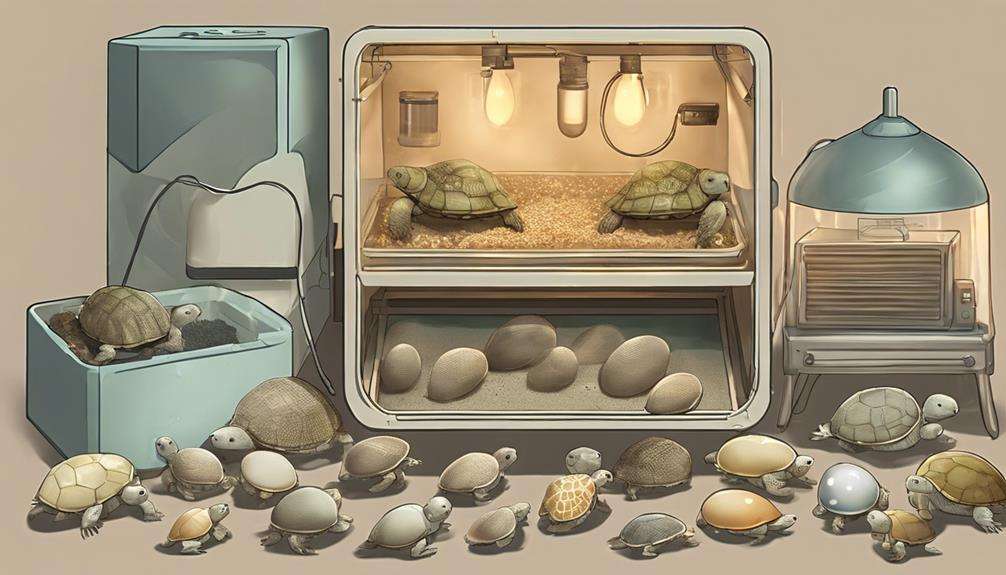
Ensuring prime conditions for the hatching and care of rare turtle hatchlings is paramount for their successful development and well-being. Rare turtle hatchlings often have unique dietary and habitat requirements that necessitate specialized care. It's important to provide a suitable environment with precise temperature and humidity levels to support their health and growth. Additionally, these hatchlings may benefit from specific supplements or vitamins to make certain they receive adequate nutrition for proper development.
Monitoring the behavior and growth of rare turtle hatchlings closely is essential to detect any health issues early on. Any deviations from normal behavior or growth patterns should be addressed promptly to make certain the hatchlings' well-being. Consulting with experienced breeders or veterinarians who are familiar with the specific species can provide valuable insights and guidance on caring for rare turtle hatchlings effectively.
Ensuring Health and Survival of Offspring
Maintain a varied and nutrient-rich diet for pregnant female turtles to support peak egg production and embryo development. A diet rich in calcium, vitamins, and minerals is essential for the health of the female turtle and the proper formation of strong and viable eggs.
Monitoring the nesting area closely is important to prevent predators from disturbing the eggs or harming the nesting female. Predation can impact the survival rate of the offspring. Ideal temperature and humidity levels in the incubation area are crucial for the proper development of turtle eggs. Fluctuations in these environmental factors can lead to developmental issues or even the death of the embryos.
Handle newly hatched turtle offspring with care to prevent stress and provide a safe environment for their initial growth. Adequate nutrition, warmth, and a secure habitat are essential for the health and survival of the young turtles.
Seek veterinary guidance and support for any health concerns or complications that may arise during the breeding process to guarantee the survival of the offspring. Regular check-ups and prompt medical attention can greatly increase the chances of a successful breeding program.
Frequently Asked Questions
Can Turtles Breed With Different Species?
Turtles cannot breed with different species due to genetic incompatibility, resulting in hybrid offspring that are typically sterile. Interspecies breeding should be avoided as it can lead to genetic abnormalities and health issues in offspring.
Are Turtles Hard to Breed?
Breeding challenges can vary among turtle species. Understanding their unique needs, such as specialized diet or habitat requirements, is important. Careful research, observation, and expert guidance are key for successful breeding of uncommon turtles.
Is Breeding Turtles Profitable?
Breeding challenges can impact the profitability of breeding turtles. Factors like initial costs, success rates, and market demand influence profitability. Specialized care, equipment, and knowledge are essential for uncommon turtle varieties, affecting overall costs.
Can I Have Two Different Breed of Turtles in a Tank?
You shouldn't mix different turtle breeds in one tank. Tank compatibility is important for their well-being. Varying needs can lead to aggression and health risks. Keep them separate to guarantee proper care and avoid conflicts.
Conclusion
Now that you have mastered the art of breeding uncommon turtle varieties, remember that patience and attention to detail are key.
By carefully monitoring environmental conditions, selecting ideal breeding pairs, and providing a suitable nesting environment, you can confirm the health and survival of these unique turtle species.
Keep in mind that conservation efforts and genetic diversity play a vital role in maintaining the population of these rare turtles for future generations.
